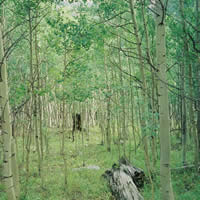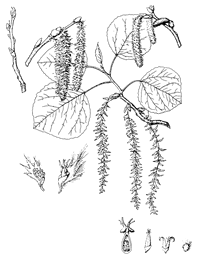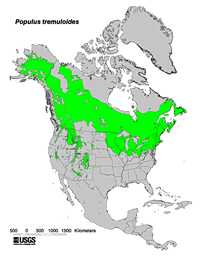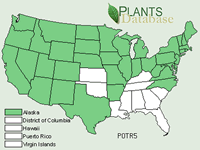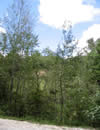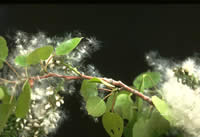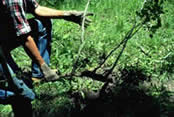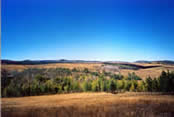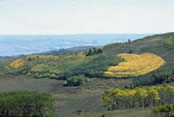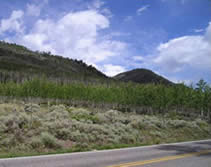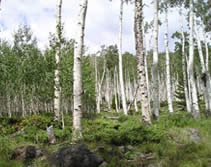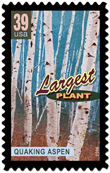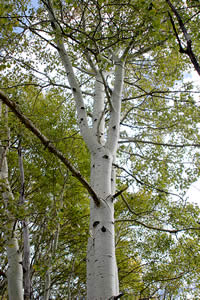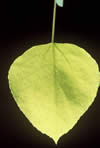USDA Forest Service Celebrating Wildflowers
|
|
|
 |
|
How Aspens Grow
Quaking Aspen (Populus tremuloides)Aspen are medium-sized deciduous trees, commonly 20 to 80 feet in height, and 3 to 18 inches diameter. Trees more than 80 feet tall and larger than 24 inches diameter are occasionally found. Their bark is smooth, greenish-white, yellowish-white, yellowish-gray, or gray to almost white in color. The green color is from chlorophyll in the bark. Their bark may become rough and fissured with age. Aspen leaves are are thin, firm, and nearly round, 1 1/2 to 3 inches diameter. They are pointed at the apex and rounded at the base, with many small rounded to sharply pointed teeth along their margins. Aspen leaves are smooth, bright green to yellowish-green, dull underneath, until they turn brilliant yellow, gold, orange, or slightly red in the fall. The leave's small stem (petiole) is flattened along its entire length, perpendicular to the leaf blade. The flattened stem allow the leaves to quake or tremble in the slightest breeze; hence, their name. The leaves of young sucker aspens may be much larger, sometimes 7 to 8 inches long. Aspen trees usually do not live more than 150 years, though they may persist more than 200 years. It grows on many soil types, especially sandy and gravelly slopes, and is quick to pioneer disturbed sites where there is bare soil. It grows best where soils are moist and sunshine is plentiful. Aspen is intolerant of shade, and does not compete well with more shade-tolerant conifer species. Quaking aspen is an aggressive pioneer species. It readily colonizes burned areas and can persist even when subjected to frequent fires. In the Central Rocky Mountains, the extensive stands of aspen are usually attributed to repeated wildfires. It may dominate a site until replaced by less fire-enduring but more shade-tolerant conifers. Quaking aspen is the most widely distributed native North American tree species, growing in greatly diverse regions, environments, and communities. It occurs across Canada, through the United States, to Mexico, in a variety of habitats. In the western United States, aspen is generally found at 5,000 to 12,000 feet elevation. Aspen occurs in extensive pure stands in some areas, while in others, it is a minor component of the forest landscape. Most of the aspen forest in the United States is found in Utah and Colorado, though it is also scattered throughout all of the western states. Aspen provide habitat for a wide variety of wildlife, including hare, moose, black bear, elk, deer, ruffed grouse, migratory birds, and a variety of smaller animals. Aspen stands produce livestock forage, biomass, and are a source for a variety of wood products. Aspens are visually appealing, as they provide contrast to the dark conifers during all seasons; and in the autumn, tourists come to the West to see the brilliant fall colors of the aspen groves. ReproductionAspen reproduces both by seeds and by root sprouts, though sprouting is the most common and successful form of reproduction. Aspen produces small flowers, on catkins that are 1-2 inches long. These flowers are produced in the early spring before the leaves grow on the trees. Aspen is dioecious, with male and female flowers normally borne on separate trees. The catkins produce small fruit that split to release lots of tiny, cottony seeds that are dispersed by the wind. Germination occurs within a couple days of dispersal provided the seeds reaches a suitable moist seedbed. Few aspen seedlings survive in nature due to the short time a seed is viable, lack of moisture during seed dispersal, fungi, adverse day/night temperature changes, and unfavorable soil conditions. Aspen is noted for its ability to regenerate vegetatively by shoots and suckers arising along its long lateral roots. Root sprouting results in many genetically identical trees, in aggregate called a "clone". All the trees in a clone have identical characteristics and share a root structure. The members of a clone can be distinguished from those of a neighboring clone often by a variety of traits such as leaf shape and size, bark character, branching habit, resistance to disease and air pollution, sex, time of flushing, and autumn leaf color. A clone may turn color earlier or later in the fall or exhibit a different fall color variation than its neighboring aspen clones, thus providing a means to tell them apart. Aspen clones can be less than an acre and up to 100 acres in size. There can be one clone in an aspen grove or there can be many. As aspen stands mature, they may begin to deteriorate as openings in the forest canopy are left by dying trees. Often, in the West, aspen is replaced by conifers in the absence of disturbance. On dryer sites, aspen may revert to rangeland dominated by shrubs, forbs, and grasses. However, root suckering will generally occur in the aspen stands as they deteriorate or as they are disturbed by fire or other events. When an aspen tree dies or as light becomes available from openings, chemical signals from the tree to the roots stimulate new sprouts to start growing. Through this regrowth, an aspen clone usually lives much longer than its individual trees. Even though individual aspen trees are not very old, aspen clones can be hundreds of years old. NOTE: The video content presented here requires JavaScript to be enabled and the latest version of the Adobe Flash Player. If you are you using a browser with JavaScript disabled please enable it now. Otherwise, please update your version of the free Flash Player. Watch how aspens grow and reproduce by sprouting. Courtesy of D. Bartos. The largest and oldest known aspen clone is the "Pando" clone on the Fishlake National Forest in southern Utah. It is over 100 acres in size and weighs more than 14 million pounds. That is more than 40 times the weight of the largest animal, a blue whale. It has been aged at 80,000 years, although 5-10,000 year-old clones are more common. Old aspen trees get sick, weak, and die, or a fire or other disturbance might kill them. Even after they die, they provide homes and food for many small animals. The nutrients from decomposing wood and leaves return to the soil where they are used by the new generation of flowering plants and trees. Aspens that QuakeTake some time this year, during the spring, summer, or fall, and visit an aspen stand on one of our western national forests. Find a sunny spot, lay or sit down on the ground and listen to the trees whisper to one another as they make their quaking sound. The soft whispering rustle of a quaking aspen is unlike the sound of any other tree in the forest. Quaking aspen is America's liveliest tree. With just the slightest breeze, its round leaves tremble almost incessantly, like thousands of fluttering butterfly wings. Watch the twinkling of just one leaf. The stem, from one and one-half to three inches long, is flat and turned at right angles with the blade of the leaf. This unique leaf stem allows the leaves of the aspen to quake. |
|
| NOTE: PDF format links require the Adobe Acrobat Reader to view. | |
| top | Disclaimers | FOIA | Privacy Policy | Quality of Information | Photo Credits & Use |
Location: http://www.fs.fed.us/wildflowers/communities/aspen/grow.shtml
Last modified: Tuesday, 24-Jun-2008 21:53:17 EDT
